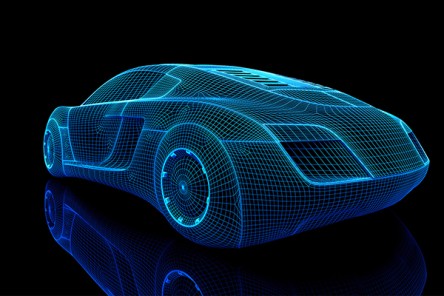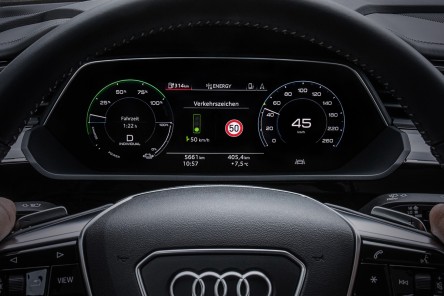Aerodynamics specialists like Dr. Kentaro Zens also like to express the savings with the battery equivalent directly in euros: Each metre gained can be directly converted into costs which must be invested in a larger battery in order to reach the same range increase. Of course Kentaro could also get more streamlining from a car on the conventional path. For this he would only need models, prototypes and approximately 1,000 hours in the wind tunnel. Or he and his team grasp the most up-to-date opensource- software and performance of 25,000 Audi computer cores and thereby reduce the expensive test time with real hardware to a few hundred hours.
Range is one of the most important performance indicators of electric cars. Unlike vehicles with combustion engines the air resistance of an E car directly affects its range more than, for instance, the weight: Each thousandth part which a manufacture saves in the cw-value –the measure for the flow resistance of a body, is conterminous with 800 meters additional range.
Flow measurement on the computer
‘We are so to speak calculating the flow backwards’, Kentaro explains the procedure with prototype free aerodynamic development ‘How would the cw value sink if the air was channelled differently?’ From this question the PSW aerodynamic specialists have created a type of virtual map of the vehicle surface on the computer, which shows them precisely, where and how the chassis must be deformed, in order to reach the optimum flow with as few replacements as possible.
The team then works along the car millimetre by millimetre: While many details of the vehicle front are already specified by the brand design and standard parts used, the cooler offers great potential for aerodynamic improvements. During combustion the air streams diffusely through the engine space. This burns. By contrast with electric vehicles the air feed through is strictly specified with channels, which has an advantageous effect on the air resistance. In addition, the reduced cooling requirement of an electric drive means the air inlet can be completely closed at times. Flaps in the cooler can prevent any influx of air and improve the air resistance of the vehicle by up to ten percent.
In addition, Kentaro and his team optimise the vehicle design and above all the details like the exterior mirror and wheels up to the spoilers and rear lights. Not even the vehicle underside is spared by aerodynamic specialists. Without the gaps of a combustion engine the E vehicle, with its nearly smooth under body, is much sleeker in the flow. Each corner, each edge, each millimetre of a vehicle can affect the aerodynamics and is therefore tested, scrutinized and if necessary redesigned. At the same time Kentaro must consider each modification holistically. For instance, about 200 working hours are invested to improving the impairments of the cw value through the exterior mirror of eight to six thousandth. It is an interesting puzzle with many variables that the PSW flow experts resolve each day. Because Kantaro’s work touches further sub-areas of vehicle development, his department is also excellently networked internally at PSW. For instance, in the team, aerodynamic specialists tinker at the rear spoilers with concept developers and kinematic experts. They hold talk shops together over the bumper with car body specialists. This interdepartmental collaboration is almost as important for the optimum result as the great specialist knowledge, the immense experience as well as the high performance computing cluster of Audi.

Complex tasks, source open software
The greatest advantage is to conduct aerodynamic measurements on the basis of simulations instead of the usual prototypes or models at a scale of 1:4: Kentaro can already record his work in a very early design phase. All he needs is a 3D model of the vehicle, which he dismantles with his colleagues into 100 million small volume cubes, before the open source software OpenFOAM calculates flow equations at each nodal point. Previously, the data preparation alone would have taken two weeks, an immense expenditure of time, during which each model iteration would occur again. With increased experience and automation Kentaro and his team could reduce the time needed by more than a third. The dynamic development process enables tightly scheduled revision phases and in the end again saves the PSW customer time and money.
With the development of a forthcoming electric sports car PSW has greatly expanded its competences in the prototype free aerodynamic development. The intermediate results and prognosis are promising, so that Kentaro and his colleagues will already be busy working for the future: In future, the aeroacoustics of a vehicle, in other words the noise generation through the air stream, will be simulated and optimised with computer support. For more details about this extremely complex topic see the information box ‘A lot of expense for less noise - the complexity of aeroacoustics’. Also the changing of simulation parameters from the standard test case ‘Wind comes directly from the front’ to the more realistic road based ‘Wind comes from the side or from the front at an angle’ is currently explained at PSW.
Each car needs a chassis and whoever optimises it aerodynamically has range quasi at no charge
Deep learning and neuronal networks could in future play a big role in automotive development , even if Kentaro warns that a vehicle optimised aerodynamically by a computer loses much of its visual character. The appearance of a vehicle must not be sacrificed at any price to its aerodynamics. For this reason the PSW aerodynamic department works hand in hand with designers: Kentaro often sat with a tail light designer in the wind tunnel and with him cut the perfect stalling angle, until all participants were satisfied in a visual as well as flow-mechanical sense
More than just hot air
Whoever speaks to Dr. Zens quickly realises how fired up he is about his subject and the change, which brings prototype free aerodynamic development into his professional life. Therefore, he will also have a lot of time in the future to rave to designers about the perfect line, talk shops and the PSW customers who are enthused about the benefits of aerodynamic range increase. In the end this also costs time and money, but thanks to the advanced simulations of Kentaro’s department, significantly less than before.

